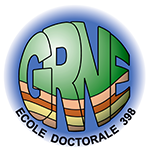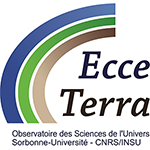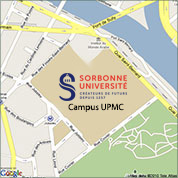Séminaire ISTeP - Henri Leclère
(Liverpool)
Evolution of fluid pressures and fluid-fault interactions across the upper continental crust inferred from seismological, mechanical and geochemical analyses
The influences of fluid overpressures on fault reactivation and earthquake triggering are investigated at the crustal scale. In order to reach this goal geological, seismological, mechanical and geochemical analyses have been carried out along an active dextral strike-slip fault system in the Ubaye-Argentera region (southern French-Italian Alps).
This fault system is in relation to the 2003-2004 Ubaye seismic swarm (Jentatton et al., 2007) occurring in the crystalline basement, and outcrops in the Argentera crystalline massif located further south. The presence of fluid overpressures in the fault zone has been evidenced during the analysis of the 2003-2004 seismic swarm (Daniel et al., 2011, Leclère et al., 2012) and by the presence of quartz-chlorite mineralized veins (i.e. hydraulic fracturing) along the faults outcropping in the Argentera massif.
We propose to investigate the interactions between fluid pressure and fault mechanics across the upper continental crust from the analysis of the 2003-2004 Ubaye swarm and the quartz-chlorite veins associated with a fault located in the continuity of the fault of the 2003-2004 Ubaye swarm.
The evolution of fluid overpressures during the 2003-2004 Ubaye seismic swarm were analyzed by using focal mechanisms of 74 events and mechanical model based on the Mohr-Coulomb theory. The results show that the seismogenic zone of the Ubaye region is characterized by the development of supra-hydrostatic fluid overpressures in fault zone by creep compaction. The hydrogeological context of the Argentera massif suggests that the fluid has a meteoric origin. Conversely, the mechanical (i.e. Mohr-Coulomb model) and geochemical analyses (i.e. chemical and isotopic compositions) of the quartz-chlorite veins show that these veins were formed at or near the base of the seismogenic zone and with a fluid having a metamorphic origin and a lithostatic fluid pressure.
These results allow to propose a conceptual model of the interactions between fluid, fault and earthquake across the upper continental crust where the brittle-ductile transition appears as an important limit separating two reservoirs with different seismic and hydro-mechanical behaviors.
19/03/2014 à 12h30, Salle de Conférence de l'UFR (Tour 46-56, 2ème étage)
Egalement dans la rubrique
Chiffres clés (Mars 2025)
L'ISTeP comprend 131 membres dont :
Permanents (66)
- Professeurs : 17 (+2 PAST)
- Maîtres de conférence : 26
- Directeurs de recherche CNRS : 1
- Chargés de recherche CNRS : 1
- ITA : 19
Personnels non permanents (65)
- Collaborateurs bénévoles / émérites : 17
- Chaire de professeur junior : 1
- Enseignants-chercheurs contractuel : 2
- 1 MCF accueil en délégation
- ATER et Post-Docs : 9
- Doctorants : 32
- ITA-BIATSS : 3





